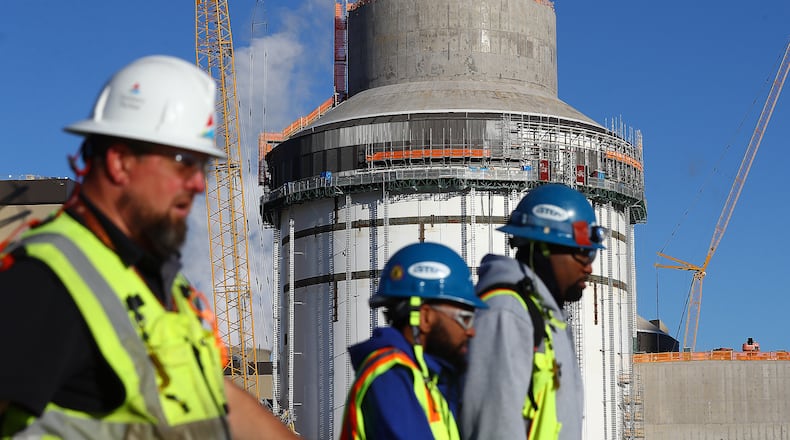Southern Company, the electric utility overseeing the beleaguered Plant Vogtle nuclear expansion near Augusta, said Thursday that the project is being delayed once again as costs continue to climb.
That raises the possibility the company’s roughly 2.6 million Georgia Power customers, already on the hook for billions of dollars, will pay even more to finance the first big nuclear project in the U.S. in decades. The project is already several years late and billions over budget.
Atlanta-based Southern, the parent of Georgia Power, disclosed Thursday a $920 million financial charge in the fourth quarter of 2021 related to Vogtle. It also pushed back the startup dates for its two new nuclear units in Georgia by three to six months.
The plant’s new Unit 3 is now slated to come online between December 2022 and March 2023. Unit 4 is scheduled to be operational between September 2023 and December 2023.
Southern partially attributed the latest delay to incomplete and missing inspection records, which are required for the plant to load nuclear fuel. It said it reduced the backlog by more than 30% in recent weeks as it works its way through tens of thousands of records for materials and equipment installed in the first of its two new units.
“We just had to go, ‘stop, we’ve got to do a complete review of all of these inspection reports,’” Tom Fanning, Southern’s chief executive, told investors Thursday. “I am frustrated about it but it is something we have to do.”
The disclosure came as Southern disclosed a nearly $1.7 billion loss for the 2021 calendar year from the project, despite still booking an overall company profit.
Many of Georgia Power’s customers already are paying Vogtle’s financing costs — to the tune of nearly $900 on average per ratepayer. Still to come as of late last year: a $185-a-year increase in average residential rates to cover construction costs if state regulators approve all of the company’s Vogtle costs, according to monitors and state staffers.
Vogtle’s proponents say the project will bring a reliable, carbon-free source of power to Georgians for upwards of six decades, making the state a leader as the country moves away from fossil fuels to combat climate change.
But some independent monitors have raised fresh concerns that Georgia Power and its parent Southern have been giving unreasonable projections about the project to justify its costs to Georgia’s Public Service Commission, or PSC, the elected body that regulates Georgia Power.
Estimates vary, but some observers believe the construction and financing cost of the expansion project has roughly doubled since it was first announced, perhaps to more than $28 billion for all the project’s owners.
Southern officials said Thursday that nearly half of the latest fourth-quarter charge, about $440 million, was to cover the cost overruns for the plant’s other owners, which include Oglethorpe Power, the Municipal Electric Authority of Georgia and Dalton Utilities. Those other companies have been disputing how to share costs and must reaffirm their commitment to the project in the weeks ahead.
Passing that portion of the bill to Georgia Power’s customers is “100% off the table,” Dan Tucker, Southern’s chief financial officer, told The Atlanta Journal-Constitution in an interview Thursday.
Tricia Pridemore, the PSC’s chairperson, said the five-member body met Thursday morning to review Vogtle’s progress for the first half of 2021. It’s not scheduled to evaluate the details for the second half of 2021 for several more months.
Pridemore declined Thursday to weigh in on Southern’s latest disclosures but said the regulatory process is “arduous because it’s important.”
“The state of Georgia will have 60 to 80 years of carbon free power that runs 24 hours a day, seven days a week, 365 days a year,” the Republican said. “And it allows Georgia to be a leader for nuclear energy across the country … There’s a great deal of confidence that comes from this.”
Liz Coyle, executive director of the consumer advocacy group Georgia Watch, called Thursday’s developments “very bad news” but “not a surprise.”
“Expert witnesses hired by the (PSC) to monitor the project already predicted these additional delays and cost overruns,” Coyle said. “We absolutely do not think Georgia Power’s captive ratepayers should have to bear the burden of these massive cost overruns.”
Tucker said Southern has been “incredibly transparent and forthcoming with every update of the project.”
He said the company has “preserved the right” to return to the PSC after both Unit 3 and 4 are online to request that other additional costs be covered by ratepayers. But Southern’s “financial outlook assumes that none of those costs are borne by Georgia Power’s ratepayers,” he said, adding that the brunt of the charges has been borne by company shareholders so far.
The utility predicted early last year that Georgians finally would get electricity from the first of Vogtle’s two new reactors by November 2021, nearly 11 years after customers began paying for it and more than five years after initially planned. But within months, the company pushed back the projected completion date of the reactors four times.
Overall, Southern posted a fourth-quarter loss of $215 million, compared with a $387 million profit in the year-earlier quarter. For the full year, it booked a $2.39 billion profit, down from $3.12 billion in 2020.
IMPACT ON CUSTOMERS
Georgia Power customers’ bills have for years included project costs, an allowance approved by the state Legislature and then-Gov. Sonny Perdue.
By the time the construction work is completed, the average Georgia Power residential customer will have paid nearly $900 toward Vogtle’s expansion, according to a Public Service Commission staff and monitor report.
Then customers are expected to pay more as construction costs are rolled into their bills.
VOGTLE TIMELINE
1970: Georgia Power’s Board of Directors votes to build a four-unit nuclear power facility.
1989: Plant Vogtle two reactors are fully online at a cost of $9.2 billion, far more than originally projected.
2009: Georgia Public Service Commission approves Georgia Power’s request to begin construction on two new Vogtle reactors. State lawmakers and Gov. Sonny Perdue allow Georgia Power to pass on financing costs to customers before the project is slated to be completed in 2017. Outside groups and PSC staff warn about risk of higher costs and delays.
2011: Nuclear fee for financing added to Georgia Power bills.
2012: Contractors warn of project delays. Contractors sue Vogtle’s owners for more than $900 million. Georgia Power sues back.
2013: Georgia Power announces delays and increased costs, but says no further delays are expected.
2015: The company and construction contractors sue each other over delays that add more than $3 billion to the project and three years to the completion date.
2016: Georgia Power agrees to controls on the project’s costs and to short-term profit penalties if the project isn’t completed by the end of 2020.
2017: Project manager Westinghouse files for bankruptcy protection, eliminating some cost protections for project owners and their customers. Plug is pulled on a similar nuclear project in South Carolina. Georgia Power’s parent company discloses more Vogtle delays and costs.
2018: Georgia Power announces Vogtle’s cost will increase by more than $2 billion, some of which the company said it wouldn’t try to pass on to customers. Georgia Power’s Vogtle co-owners agree to stick with the project. PSC staff express doubt about the company’s latest schedule and warn it could lead to bad decisions.
2019: The Trump administration OKs $3.7 billion in loan guarantees for Vogtle, on top of $8.3 billion in loan guarantees made during the Obama administration. State monitors and staff warn about likely higher costs and more delays.
2020: Nearly 2,000 workers are cut from the Vogtle project as the pandemic grows. In late October, both Georgia Power’s retiring CEO and his replacement express confidence in meeting the latest deadlines.
February 2021: Company reasserts its ability to meet scheduled deadlines, but discloses additional costs.
March 2021: Company discloses more quality problems on project and efforts to solve them.
April 2021: Company says first reactor, slated to be in operation in November, won’t be finished until late December.
May 2021: Company says first reactor now won’t be in operation until sometime in the first three months of 2022.
June 2021: Independent monitor for state predicts first reactor won’t be in operation until the summer of 2022, at the earliest. U.S. Nuclear Regulatory Commission announces elevated review into quality problems and how they were addressed.
July 2021: Company announces more cost increase for its share of the project and extends timetable for each reactor by another three to four months.
August 2021: NRC rules that it should increase oversight of the project as a result of quality and control problems.
October, 2021: Company announces an additional three-month delay to its schedule, citing “construction challenges” and need for comprehensive testing to ensure standards are met.
November 2021: Company announces further cost increases.
December 2021: Independent monitors and PSC staff say total construction costs could rise another $1 billion and predict the first new reactor won’t go online until November of 2022 or even February of 2023 and that the second reactor will be finished a year later.
February 2022: Company announces $920 million financial charge in the fourth quarter of 2021 and pushes back the startup dates for its two new nuclear units by three to six months. The first unit is now slated to come online between December 2022 and March 2023; the second unit between September 2023 and December 2023.
About the Author
Keep Reading
The Latest
Featured



